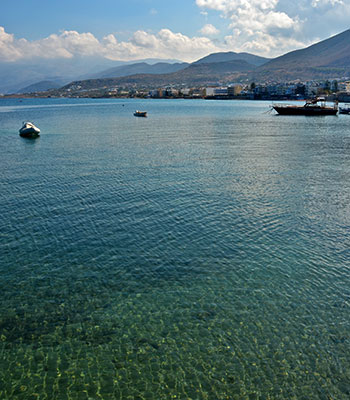 Chersonissos Port village is located 24km east of Heraklion, on the northern coast of central Crete, in a wider area of natural beauty. It is the largest tourist resort of Crete and is famous for its beautiful beaches and its lively nightlife. It is referred to as Port of Chersonissos (Limenas or Limani in Greek) because it was in fact the port of Chersonissos village.
Chersonissos Port village is located 24km east of Heraklion, on the northern coast of central Crete, in a wider area of natural beauty. It is the largest tourist resort of Crete and is famous for its beautiful beaches and its lively nightlife. It is referred to as Port of Chersonissos (Limenas or Limani in Greek) because it was in fact the port of Chersonissos village.
Chersonissos Port was, in the past, a picturesque seaside fishing village while its tourist development began in the 1960s and, within a few decades, it became the largest and most popular tourist resort in Crete. Nowadays, it is worldwide known as a cosmopolitan tourist resort, not only in the Mediterranean but also globally, with a remarkable tourist infrastructure that attracts thousands of tourists – Greeks and foreigners – every summer. It was named after the small peninsula (Chersonissos in Greek) formed in the area of the small port and it is beautifully situated around a bay.
Chersonissos Port has a long history depicted in the many monuments and ruins that one finds in the town. It was an important port and commercial station in the area from ancient times to Roman and Byzantine times. Chersonissos Port has been inhabited since the Minoan years. In the same place as today, there was the city of Cheronissos or Chersonasos. Traces of Minoan settlements have been found on Kastri Hill , in Anissaras village and an other port in Akrotiri Drapanos.
The town, during the classical period of 500-323BC, was independent and it was an administrative and economic center of the region. In Hellenistic period, 323-67BC, this was the port of the ancient city of Lyttos. A part of the temple of the goddess Vritomartis and a number of vases and jewels, from that period of time, have been found on Kastri hill.
During the Roman period, 67BC-323AD, Chersonissos Port grew and became more important than Lyttos area. The area had a port with piers and dockyards and an aqueduct, where a pipeline brought water to Chersonissos from mountainous villages in the south and it is estimated to be 14 kilometers long. It also had public baths and a large theater built in the 1st AD century. Nowadays, theater ruins have been preserved while, recently, restoration works began.
In the Early Byzantine period, 3rd century AD, Chersonissos was a bishopric and was an important center of the island. The Early Christian Basilica of Agios Nikolaos, located 2km east of Chersonissos Port, by the sea is one of the most important findings of that time.
On Kastri hill, the visitor can see the ruins of another Early Christian Basilica of the 5th century, where, today, a part of the impressive mosaics on the floor with patterns of plants and geometric shapes is distinctive. The period of the decline of the city dates back to the 7th AD century and is accompanied by a gradual abandonment, as the excavation findings show. In recent years, the present settlement was referred with 133 inhabitants in the census of 1900.
At the port, the coastal pedestrian street of Agia Paraskevi ends at the picturesque chapel of Agia Paraskevi, which is located on Kastri hill with a panoramic view of the port.
Chersonissos Port is a destination with hotel units, modern infrastructure, organized beaches, restaurants, shops, lively nightlife and has everything that a visitor may need on his/her vacation. It is an area with many beautiful, small and large, blue flag beaches with sand, pebbles and crystal clear waters, organized offering many water sports options.